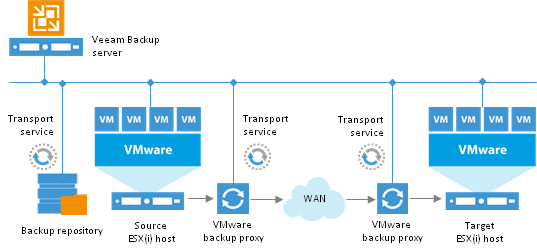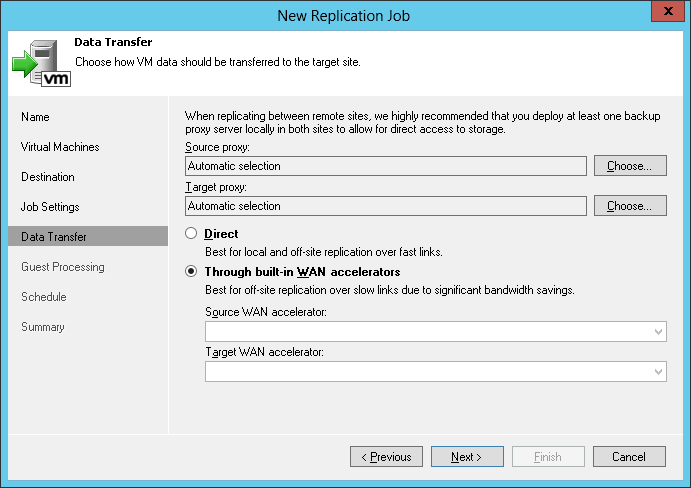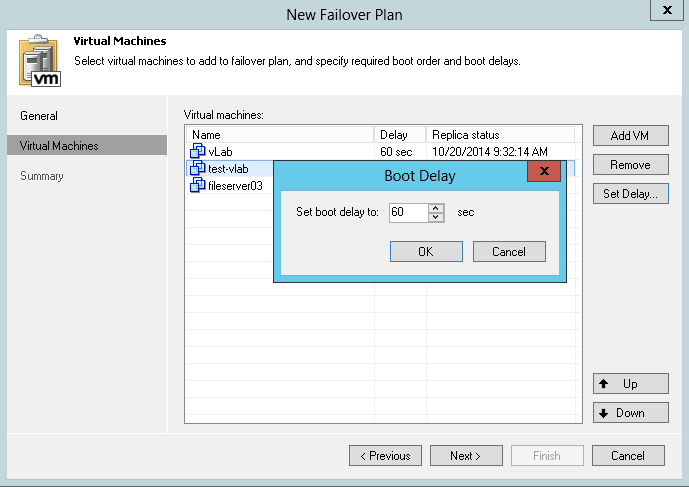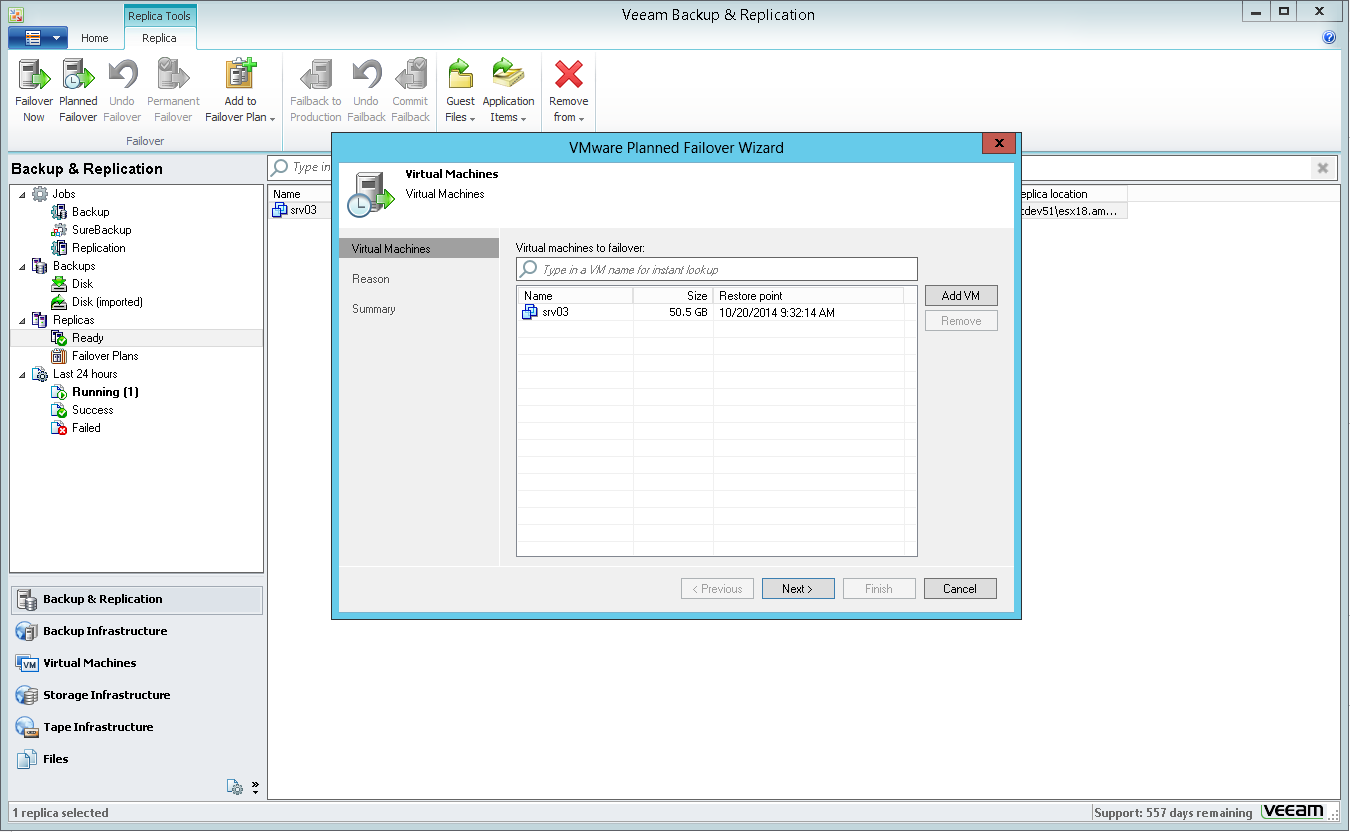What's New in Veeam Backup & Replication 8.0: Advanced Replication
- Tutorial

As you can guess from the product name, the pillars of the Veeam Backup & Replication data protection strategy are 2-in-1: backup and replication implemented in a single product.
The advantage of the backup mechanism is the ability to roll back to various restore points in the past, while the replication mechanism allows you to get a minimum indicator of the system recovery time after a failure - this is why it is especially valuable for modern data centers. Today I will talk about new replication features that will be released with the release (already in November!) Of the new version of Veeam Backup & Replication 8.0.
Replication from backup
In the settings for the replication job, you can now choose what will become the source of data for replication - this is either the storage system with the original data of the virtual machine, or a backup copy of the virtual machine (from the number stored in one or more repositories; it should be noted that the latest one is always taken backup copy).

A new option, when choosing a backup file as a data source, allows you to reduce the impact of data replication operations on production storage.
Built-in WAN Acceleration in Replication Jobs
In version 7.0, a built-in WAN acceleration was implemented for backup tasks to a remote site. This functionality allows you to do without installing and administering additional solutions specializing in optimizing WAN traffic. Since Veeam is well acquainted with the file structure of its own backups (really!), The built-in deduplicator works with such files better than WAN optimizers from third parties. Since the WAN optimization technology was successfully tested for the backup case, we thought: “Why not use it for replicas?” And in the new 8th version, WAN optimization technology was also implemented for replication.

It should also be noted that the WAN accelerator cache can be “warmed up” before starting the task by filling it with data from the existing backup repository. To do this, perform the Populate cache operation. If necessary, the cache can be reset.
Plan for switching to replica
A very important and useful innovation is the ability to plan switching to a replica: now you can prepare everything in advance, and at the right time, perform the operation with one click through the web interface, say, from a tablet, lying in a hammock or on the shores of a warm sea (however, I hope that readers will never have to perform this operation while on vacation).
In the console, switching planning looks like this:

Create a switching plan, add virtual machines from replicas, and build them in the order in which they should be started. For each machine, you can specify the duration of the wait so that each subsequent one starts strictly after the previous one has started (for example, the Exchange server will start after the domain controller).
You can create several of these planned scenarios by creating separate groups for more or less critical machines (for example, separating business application servers and test VMs). In this option, you can, for example, start a switching plan for a less important group of machines only after you have made sure that the previous scenarios have worked out successfully and that you have enough resources to operate another group.
It is recommended to test the planned switching scenarios using SureReplica technology, which appeared in version 7. It allows testing replicas for the possibility of recovery without affecting the production environment, but using a specially designed isolated virtual laboratory.
Virtual Laboratory for backups
Let me remind you how the virtual lab (or “sandbox”) works on the example of backup for the VMware vSphere platform.
- The task is assigned to the host; vSwitch is created on the host
- A proxy (a network router in a virtual machine with NAT) provides network interaction and isolation of the sandbox from the productive network, while maintaining access to the sandbox from those computers of the productive network from which network access should be saved for administrative purposes
- Using Veeam vPower technology, a given virtual machine can be launched in an isolated virtual laboratory environment directly from a backup repository and without the need to restore it to temporary storage

The picture shows an example of starting an Exchange server in a virtual lab test environment. To restore an object from the Exchange server, you must first restore the domain controller - therefore, both servers are in the restored server farm.
With respect to the virtual laboratory, several significant points should be undone:
- It consumes part of the network resources
- It is tied to some host. If the host is shut down, for example, for servicing, the virtual lab will be unavailable
- Running all the necessary virtual machines in the sandbox may take longer than starting them in production, since some of the computer time is consumed by the mechanisms of the sandbox itself, and storage systems that store backups are often less productive than production storage systems.
A “sandbox” based on backup site resources can also be used for such resource-intensive operations as testing patches and new software versions: it would be wise to first test them on “cats” in a “virtual copy”, rather than immediately put them on production.
You can read more about this in the post “Crash Recovery:“ Network Sandbox ”Based on vSphere and Hyper-V in Veeam Backup & Replication v7”
Virtual Lab for Replicas
Using the virtual laboratory for replicas , which I started talking about above, the administrator will be able to automatically check the correctness of the replicas (SureReplica), as well as use replicas to work with the "sandbox". Replica technology has the following advantages:
- A virtual laboratory for replicas can do without consuming production resources - you can use a host to create it even from a remote site designed for disaster recovery and not loaded with production tasks.
- Unlike backups, replicas are stored on disks in the original VMware format, and not in a compressed and deduplicated archive copy format. This allows you not to waste computing resources on format conversion, which gives an increase in productivity.
I also note that in Veeam Backup & Replication 7.0 SureReplica could be used only for the VMware vSphere platform, and in the new version it is supported for the Hyper-V platform as well.
Scheduled switching
Now, scheduled switching can be performed directly from the console, which simplifies the administrator’s work during data center migration, as well as with regular maintenance of servers running in the production network. The operation occurs without data loss and with a minimum shutdown: the source virtual machine shuts down, all the latest changes are replicated to the target virtual machine, then the target machine turns on.

Additional links:
Other innovations of Veeam Backup & Replication v8, which will be released in November, can be found in these posts:
- New features in Veeam Backup & Replication 8.0: automatic read / write intensity control
- NetApp Storage Hardware Snapshot Support in Veeam Backup & Replication v8
- What's New in Veeam Backup & Replication v8: Veeam Explorer for Active Directory and Veeam Explorer for Microsoft SQL Server
- NetApp Storage Hardware Snapshot Support in Veeam Backup & Replication v8
- Veeam Availability Suite v8 Website
